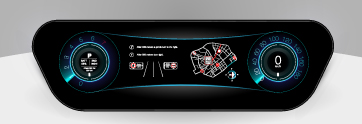 Application specific Master Bond liquid adhesive formulations have been developed to meet the growing demand for advanced automotive display systems. These epoxy, urethane modified epoxy, silicone and UV cure compounds deliver peak performance under harsh daily road conditions, high/low temperatures, humidity, pollutants, dirt, and dust. Digital displays eliminate the need for dials, buttons, and analog gauges and have enabled riders to experience a safer, more comfortable, relaxed trip. The adoption of innovative technology is providing new opportunities for automotive manufacturers to differentiate their vehicles and increase sales in this most competitive marketplace.
Application specific Master Bond liquid adhesive formulations have been developed to meet the growing demand for advanced automotive display systems. These epoxy, urethane modified epoxy, silicone and UV cure compounds deliver peak performance under harsh daily road conditions, high/low temperatures, humidity, pollutants, dirt, and dust. Digital displays eliminate the need for dials, buttons, and analog gauges and have enabled riders to experience a safer, more comfortable, relaxed trip. The adoption of innovative technology is providing new opportunities for automotive manufacturers to differentiate their vehicles and increase sales in this most competitive marketplace.
Master Bond compositions are utilized for structural bonding, sealing, thermal management, optimizing electrical insulation, and maintaining dimensional stability. These products can provide engineers design flexibility and cutting-edge solutions for the assembly of the following types of automotive displays:
- Automotive instrument clusters
- Center console displays
- Rear seat entertainment
- Head-up display (HUD)
- Rear-view mirrors
Different Master Bond grades can aid in miniaturization, weight reduction, and protection against vibration, impact, shock, noise, lowering energy consumption and prolonging display service life. Optical systems have been the forefront of improving display readability by significantly enhancing picture clarity, contrast ratios, brightness, infrared refraction, and color accuracy under a range of ambient lighting conditions.
Additionally, automotive displays offer high resolution over larger display sizes, dimming capability, a wide viewing size and a speedy touch response time. Available in a variety of viscosities Master Bond liquid clear optical adhesives can be engineered to cure at room temperature, with UV light and/or with heat. Many of them can be dispensed automatically, provide outstanding durability, possess high bond strength, can be applied to a wide range of substrates.
Master Bond’s unique product portfolio of thermal interface materials can be effective in dissipating heat to accommodate increased power consumption requirements. There systems consist of thermal conductive adhesives, liquid gap fillers, encapsulants and gels. They efficiently draw heat away from sensitive PCB components, guard circuits form overheating, and against unmatched coefficient of expansion/contraction from thermal cycling. Specific compounds can be designed to exhibit versatility, low shrinkage upon cure, superb thermal stability, and consistent dependability. Specialty formulations retain superior electrical insulation properties including low dielectric constant and dissipation factor to extend display longevity. Thermally conductive gap fillers avoid slumping on vertical surfaces and are vibration damping. All grades are ROHS compliant.
High quality Master Bond one and two component structural adhesives feature outstanding bond strength between multiple material substrates. Both room temperature curing and moderate temperature curing formulas can be precisely applied on thin curved surfaces with rounded corners, complex configurations. This has allowed auto manufacturers to embed displays in more narrow areas. Our compounds can play a beneficial role in expanding the size, number, and aesthetics of these automotive cockpit displays. This extends from instrument clusters, overhead consoles, navigational systems, and smart HVAC controls to rear-view mirrors, steering wheels. These transformative changes can give drivers the ability to check information in a timelier manner, be less distracted and have prevented collisions from happening.
User friendly Master Bond products can increase productivity, reduce labor costs, energy expenses, wastage and contain no solvents. These structural adhesive systems can be engineered to exact customer specifications and can increase profitability for high volume production of automotive displays. As the market for these systems continues to evolve, Master Bond has devoted our technical expertise to help manufacture automotive displays that upgrade their client experiences. Special emphasis has been placed on:
- 3D images
- Interactive displays responsive to touch
- Integration of multiple assistive systems
- Screens over entire dashboards
- Virtual reality (VR)
- Flexible displays
- Screens for media streaming and cloud gaming
- Haptic feedback
- Augmented reality (AR)
- Large, high resolution, multi-colored displays
- Gesture recognition technology
Luxury, semi-autonomous, autonomous cars will accelerate expansion in this vital market.
